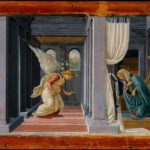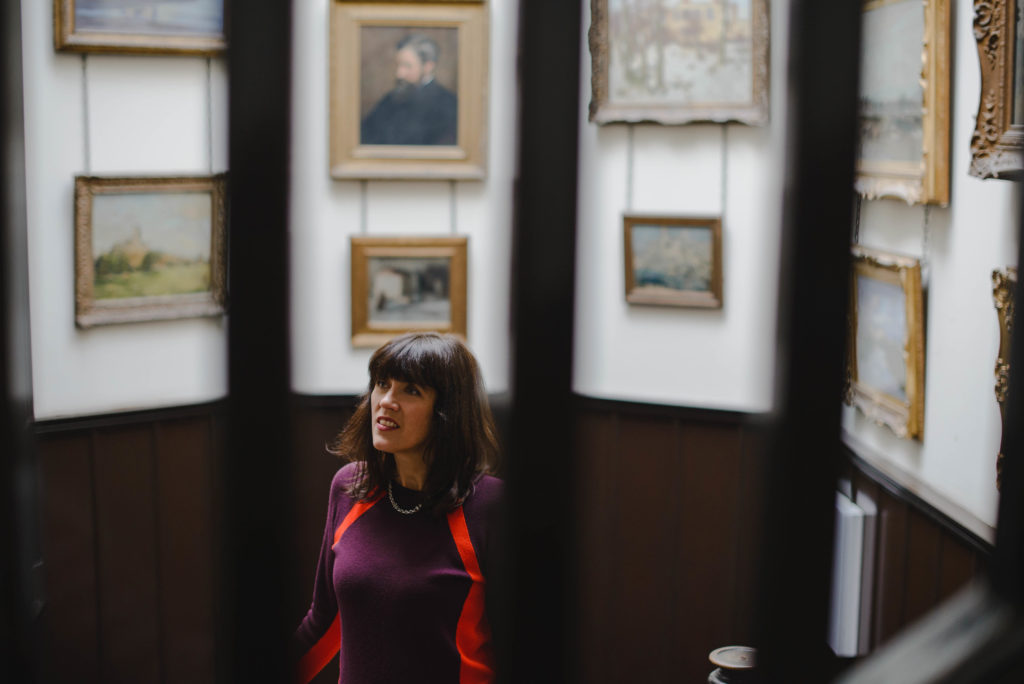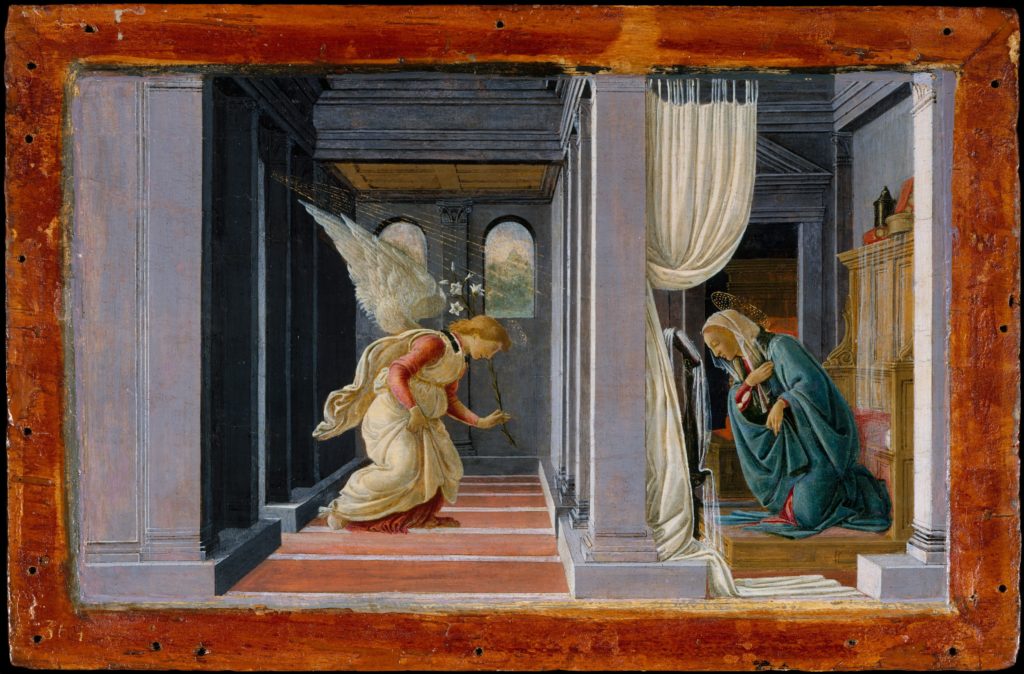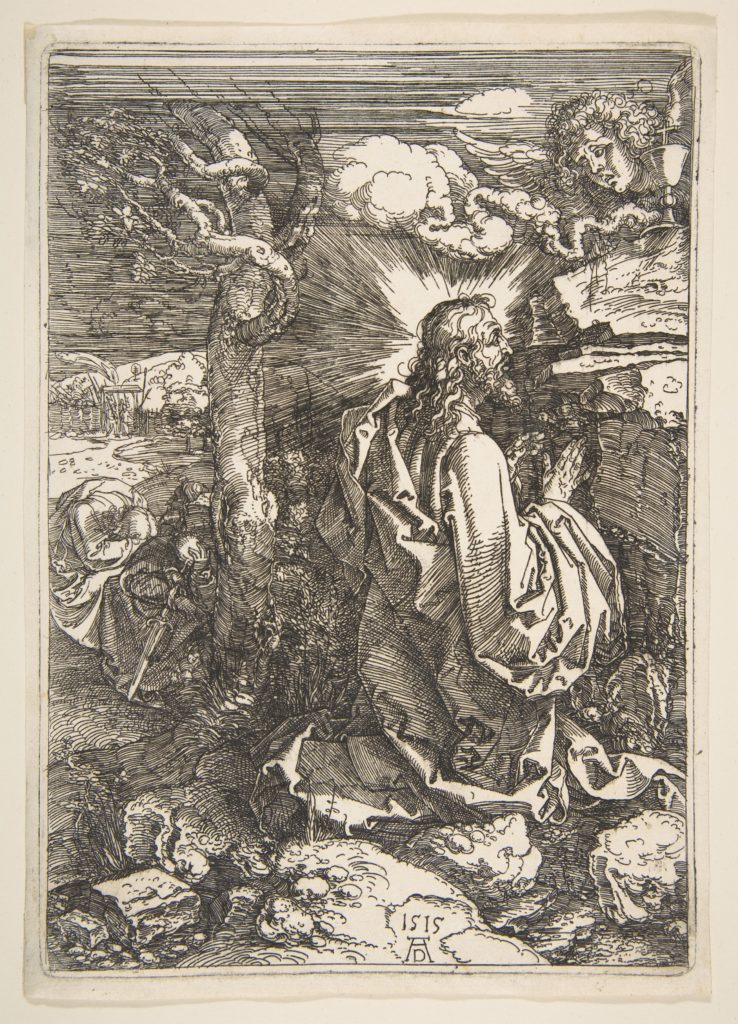
In a time of many isolations, Dr Deborah Lewer, Senior Lecturer in History of Art, has been making video podcasts to open up art to faith communities and beyond. Here she reflects on this unplanned process of discovery, and on what deep engagement with art and culture – those rich resources for connecting with human experience – can offer us in our painful present.
This was not something I ever planned to do. I’ve been on research leave this semester, busy writing a book for Reaktion Press’s Critical Lives series on the founder of Dadaism, Hugo Ball. I was also due to be in the US for three weeks in April giving a series of lectures and workshops on thinking about the intersections between art and theology. I was looking forward to working with diverse church and community groups in Lincoln, Nebraska, and to visiting and speaking at the pioneering Tri-Faith Initiative in Omaha, where the Muslim, Jewish and Christian communities have created a shared space for dialogue and fellowship. I was going to be leading a working retreat on art for clergy in Chicago. All of that, of course, was cancelled due to the COVID-19 pandemic, audiences now scattered into homes, away from people, before screens. But, in recent weeks, working from my own flat in Glasgow, I have been discovering how creative and connective work to equip people to engage deeply with art and to find resonances with questions of faith is still possible. Perhaps it is even more possible now. Certainly, in these disconcerting times, ways of finding not just quick distraction, but more lasting meaning in our painful present are urgently needed. Art and culture are rich resources for connecting with human experience and belief now and across history.

So, working closer to home, with St Mary’s Episcopal Cathedral and the Iona Community in Glasgow, I have made a series of video podcasts on works of art over the last few weeks. At a time when it’s easy to scroll, swipe, and click through the deluge of rich cultural offerings online, they are designed to enable people to take a slow, intentional and reflective look at a single work of art. (‘Slow’, in this context, refers more to the pace than the length: about ten minutes, which is, admittedly, positively supersonic compared to, say, the four hours advocated by some as the necessary minimum time to engage deeply with a work of visual art…) Each video integrates specially recorded music, from the medieval to the present, to allow space for thought, or no thought, and for looking. They reflect the importance of musical excellence in the life of the Cathedral, of singing as part of the work of the Iona Community, and of both organisations’ prominent commitment to inclusivity and engagement. The videos have been incorporated into online liturgies for Holy Week and Easter, and offered as meditations for communities and individuals of faith from many traditions across the world. They’ve also been simply shared and enjoyed by people who love learning about ways of looking closely at an artwork. There are plans to create more, and to collate them as a longer-term resource.
Themes emerged through this work around separation, isolation, fear, lament, grief and around touch, hope, solidarity, reunion and transformation. Responses came, telling us that these resonated with people who watched, thought and, in some cases, prayed.
In scripting them, I drew on 20 years’ experience as a scriptwriter and consultant for exhibitions and museum audioguide production across the world. I’ve worked over the years with Tate, Guggenheim New York and Bilbao, the National Maritime Museum, the Chester Beatty Library, the National Gallery of Ireland, the Schirn Kunsthalle and many more. There is a skill to writing for speech and, most importantly, to bringing works of art to life. Above all, I wanted to do justice to three things: art history, theology, and our present situation of crisis and social isolation. The format is modest and simple. But I wanted to take all three seriously, while allowing space for the play of the imagination. The resulting videos are intended to be as accessible as possible to a wide and very diverse audience without diminishing any of these aspects.
In my experience, a faith context – whether an act of worship, a social justice initiative or pastoral support – is uniquely conducive to this kind of closer looking, and reflecting. It naturally encourages an intentional openness, attentiveness, receptivity and a willingness to think beyond the concerns and perspectives of the immediate self. Art is a powerful means of connecting people and of mediating in fresh, even challenging ways between stories that can seem either remote or overly familiar (biblical narratives, for example) and the experiences we are living through. This has never been more so than in our time of global pandemic. Themes emerged, as I prepared the podcasts. They were around separation, isolation, fear, lament, grief and around touch, hope, solidarity, reunion and transformation. Responses came, telling us that these resonated with people who watched, thought and, in some cases, prayed.

Robert Lehmann Collection, Metropolitan Museum, New York
The project began when I was asked to contribute something to mark the Feast of the Annunication on 25th March. Rev. Oliver Brewer-Lennon, Vice-Provost of St Mary’s Cathedral in Glasgow, recorded a beautiful sung Ave Maria in the empty cathedral, just before the lockdown, and using my commentary, wove this skillfully into an 8-minute video podcast exploring a tiny Annunciation panel by Sandro Botticelli from the Met Museum in New York. It was shared across the world on social media and was viewed more than 6k times in the first week.
Next, in association with the Iona Community, we made a trio of video podcasts for Holy Week and Easter, called Agony, Lamentation and Reunion. I looked at a print, a painting and a sculpture, by Albrecht Dürer, Rogier van der Weyden and Ernst Barlach. They came out on Maundy Thursday, Good Friday and on the first Sunday after Easter (when the story of ‘doubting Thomas’ is told).

Metropolitan Museum, New York
Oliver’s editing of these modest little podcasts has been very attentive, and we thought carefully about every close-up, the pacing and all aspects of the production, learning along the way. It has opened up new opportunities too. I have now been commissioned by St Paul’s Cathedral in London to write a week’s worth of daily reflections (from 18 May), each around a work of art, as part of their special COVID-era programme serving their large dispersed community of followers across the world. It’s an exciting challenge to take a theme and explore it through five very different works of art, one each day.
Working as an arts academic in faith contexts brings its own challenges (as can, sometimes, working as a person of faith in an arts context). But it’s full of opportunity too. One of the things I love about art is how it creates a space of encounter with such potential to bring people of different faiths and of no faith together in conversation. And faith can also bring together people who love art and people who are afraid of it or think it is not ‘for them’ – something I encounter much more often than I would like. Matters of equality and diversity are urgent there too. Theological concepts underpin these works of art and are explored in the podcasts too, of course, but people of other faiths and of no faith respond very positively – I’ve had enthusiastic responses from committed atheists as well as from the most dedicated church-goers. My experience over recent weeks has been that people are keenly searching for meaning, solace, and eloquence in ways of engaging with the present. Hopefully these podcasts, and those we will produce in the future, make a modest contribution to meeting those needs, to honoring the importance of art in life and to opening up ways of being together, apart.
Dr Deborah Lewer is Senior Lecturer in History of Art. She specializes in 20th-century German art and in the intersection between art and theology. She works extensively with faith communities and with those involved in professional ministry to support and encourage engagement with a wide range of visual art and art history.

